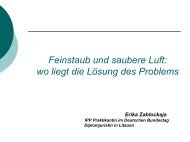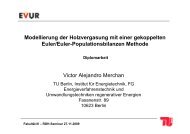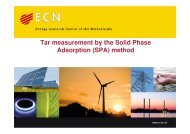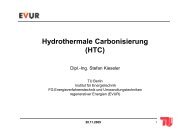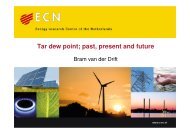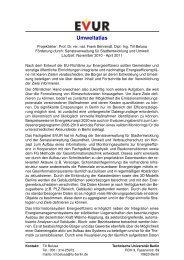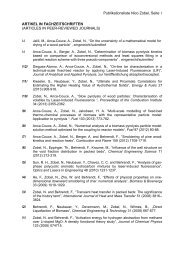Insert the title here - EVUR - TU Berlin
Insert the title here - EVUR - TU Berlin
Insert the title here - EVUR - TU Berlin
Create successful ePaper yourself
Turn your PDF publications into a flip-book with our unique Google optimized e-Paper software.
<strong>the</strong> ma<strong>the</strong>matical process and <strong>the</strong> final result. With MCDA <strong>the</strong> European school seeks to give<br />
recommendations w<strong>here</strong>as <strong>the</strong> American school tries to find an ideal solution (Roy96).<br />
Moreover, MCDA looks at <strong>the</strong> pros and cons of <strong>the</strong> corresponding alternatives without<br />
necessarily presenting a dominant solution. T<strong>here</strong>fore, <strong>the</strong> decision aiding process itself is <strong>the</strong><br />
centre of attention providing an opportunity to learn from <strong>the</strong> corresponding stakeholders.<br />
MCDM works with so called monoistic ethics only. Thus <strong>the</strong> diversity of ethical approaches<br />
within sustainable development cannot be accounted for in <strong>the</strong> evaluation process. According<br />
to Omann MCDM is not regarded as suitable for decision problems in <strong>the</strong> context of<br />
sustainable development (Omann04).<br />
In this paper <strong>the</strong> term MCDA is used in <strong>the</strong> sense of Multi Criteria Decision Analysis<br />
covering both approaches.<br />
T<strong>here</strong> are several approaches in <strong>the</strong> literature that categorize <strong>the</strong> MCDA methods (Hwang81,<br />
Zimmermann91, Polatidis06, Hobbs00). According to Polatidis et al. <strong>the</strong>re are –next to <strong>the</strong><br />
above mentioned MODM- “Utility or Value based methods”, “Outranking Methods” and<br />
o<strong>the</strong>rs (Polatidis06). Utility based methods rank <strong>the</strong> alternatives according to an aggregated<br />
single value that represents <strong>the</strong> overall performance of <strong>the</strong> alternatives. Methods such as<br />
multiattribute utility <strong>the</strong>ory (MAUT), multiattribute value <strong>the</strong>ory (MAVT) and <strong>the</strong> Analytical<br />
Hierarchie Proces (AHP) belong to this category. The outranking methods originated in <strong>the</strong><br />
European school try to find a ranking or partial ranking based on pair wise comparisons. This<br />
approach aims at building a binary relation on <strong>the</strong> set of alternatives (often called an<br />
outranking relation). Contrary to <strong>the</strong> utility or value based approach this relation is not built<br />
via a single criterion.<br />
Some reasons for <strong>the</strong> application of MCDA in a decision process are <strong>the</strong>ir ability to deal with<br />
subjective elements and qualitative criteria. MCDA methods are able to incorporate different<br />
perspectives of stakeholders by adding subjective elements such as <strong>the</strong> weighting of <strong>the</strong><br />
different evaluation criteria (Omann04). By separating subjective and objective data <strong>the</strong><br />
decision process becomes more transparent as subjective opinions are clearly communicated<br />
and are not hidden in underlying assumptions. Moreover, MCDA has <strong>the</strong> opportunity to<br />
incorporate qualitative as well as quantitative criteria. Especially ecological and social criteria<br />
are difficult to measure so that through relative scales expert opinion can be quantified and<br />
included in <strong>the</strong> decision process.<br />
On <strong>the</strong> o<strong>the</strong>r hand, trying to incorporate all <strong>the</strong>se aspects (subjective judgments, stakeholder<br />
participation, modeling of <strong>the</strong> complex environment, sustainability issues) in one method, can<br />
lead to a bulky approach, thus making it too complex to handle. The risk is that <strong>the</strong> decision<br />
maker cannot follow <strong>the</strong> method and feels uncomfortable with <strong>the</strong> solution. The main<br />
challenge is <strong>the</strong>refore to build a scientifically valid, thus manageable method (Omann04) 2 .<br />
In <strong>the</strong> next chapter preceding reviews are introduced and <strong>the</strong> methodology in this article<br />
discussed. In chapter three <strong>the</strong> literature review according to <strong>the</strong> corresponding criteria is<br />
presented. In <strong>the</strong> final chapter main finding, trends and challenges are summarized.<br />
2. FORMER REVIEWS AND METHOD<br />
2 For more detailed information on MCDA compare (Figueira05)



